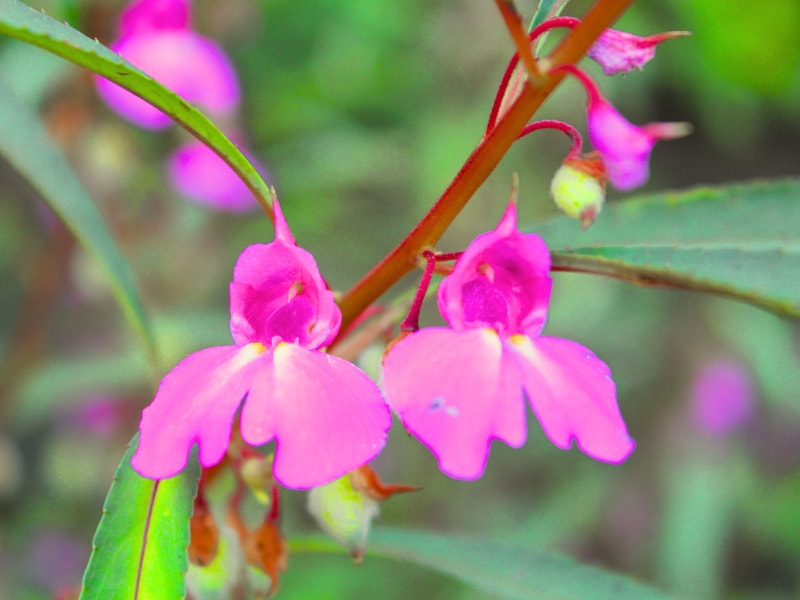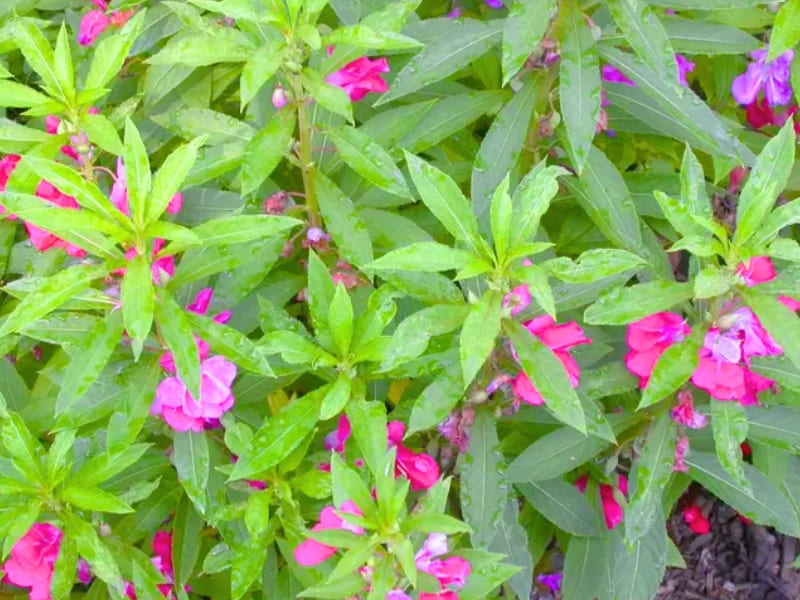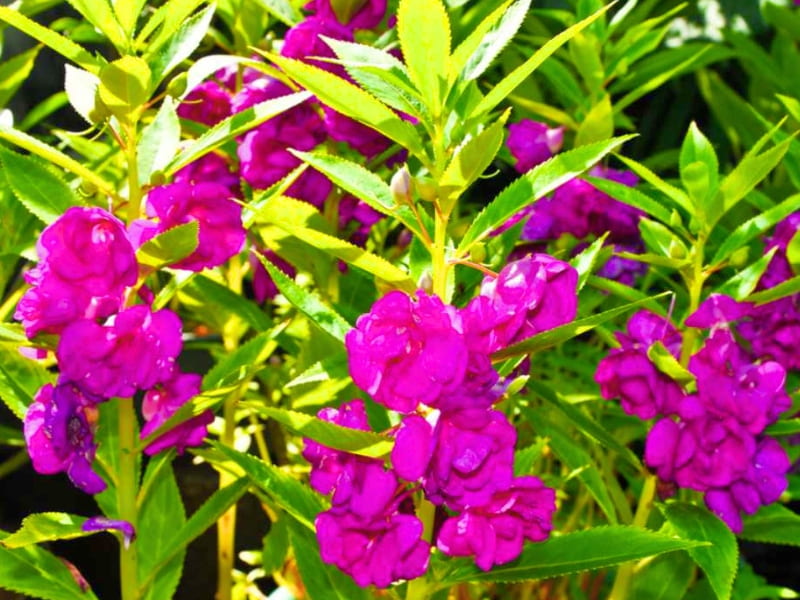Garden Balsam, also commonly known as touch-me-not, rose balsam, or spotted snapweed, and botanically named Impatiens balsamina, is a vibrant annual flowering plant celebrated for its prolific blooms and ease of care. Related keywords that describe this plant include easy-to-grow annuals, shade-tolerant flowers, and colorful garden additions.
If you’re seeking a low-maintenance yet stunning addition to your garden, or are interested in buying Garden Balsam seeds, growing from seed, planting, this guide from Gardencenterpoint.com provides everything you need. The Impatiens balsamina is the perfect plant.

Garden Balsam: A Comprehensive Overview
Garden Balsam, an heirloom favorite, has graced gardens for generations. Its popularity stems from its ability to produce a continuous display of colorful, camellia-like flowers throughout the summer and into fall. Native to South and Southeast Asia, this plant thrives in warm climates and is adaptable to various garden settings, from borders and containers to shaded areas where many other flowering plants struggle.
| Common name | Garden Balsam, Rose Balsam, Touch-Me-Not, Spotted Snapweed |
| Botanical name | Impatiens balsamina |
| Family | Balsaminaceae |
| Genus | Impatiens |
| Species | balsamina |
| Origin | South Asia, Southeast Asia |
| Life cycle | Annual |
| Plant type | Herbaceous |
| Hardiness zone | 2-11 (typically grown as an annual in all zones) |
| Sunlight | Partial Shade, Full Sun (afternoon shade preferred in hot climates) |
| Maintenance | Low |
| Water | Moderate (keep soil consistently moist) |
| Drainage | Well-Drained |
| Spacing | 12-18 inches |
| Flowering period | Summer to Fall |
| Height | 1-3 feet (depending on variety) |
| Growth rate | Fast |
| Flower color | Pink, Red, Purple, White, Bicolors |
| Stem color | Green, sometimes reddish |
| Flower benefit | Continuous Bloom, Attracts Pollinators |
| Garden style | Cottage Garden, Container Garden, Border Planting |
| Uses | Ornamental, Traditional Medicine (external use only with professional guidance), Pollinator Garden, Natural Dye (flowers) |
| Soil pH | Slightly Acidic to Neutral (6.1-7.5) |
| Propagation | Seed, Stem Cuttings |
| Pest Resistance | Generally resistant; may occasionally be affected by aphids or spider mites. |
| Disease Resistance | Generally resistant; may be susceptible to powdery mildew in humid conditions. |
| Bloom time | 60 to 70 days after sowing. |
The plant’s botanical name, Impatiens balsamina, reflects its defining characteristic: the explosive seed dispersal mechanism. When ripe, the seed pods burst open at the slightest touch, scattering seeds several feet away – hence the common name “touch-me-not.” This self-seeding habit makes Garden Balsam a reliable re-seeder in many gardens, providing a delightful surprise of new plants each year.
Garden Balsam typically grows to a height of 1 to 3 feet, with a bushy, upright habit. The leaves are lance-shaped, serrated, and a vibrant green, providing an attractive backdrop to the flowers. The flowers themselves come in a wide range of colors, including shades of pink, red, purple, white, and bicolors. They are often double-flowered, resembling miniature roses or camellias.
The appeal of Garden Balsam extends beyond its visual beauty. It’s a relatively low-maintenance plant, requiring minimal care once established. It’s also a favorite of pollinators, attracting bees and butterflies to the garden. Furthermore, various parts of the plant have been used in traditional medicine for centuries, although it’s crucial to note that internal consumption of the plant is not recommended without guidance from a qualified herbalist or medical professional.
A study published in the Journal of Ethnopharmacology (2012) explored the traditional uses of Impatiens balsamina in various cultures. The study highlighted its use in treating skin conditions, joint pain, and other ailments. However, the researchers emphasized the need for further research to validate these traditional uses and determine the plant’s safety and efficacy. Source: Nahar, L., et al. “Impatiens balsamina: A Review of its Phytochemistry, Traditional Uses and Pharmacology.” Journal of Ethnopharmacology, vol. 141, no. 1, 2012, pp. 1-14.
Varieties of Garden Balsam
Several cultivars of Garden Balsam offer a variety of flower colors and forms. Some popular varieties include:
- ‘Tom Thumb’ Series: Dwarf plants (8-12 inches tall) with double flowers in a mix of colors.
- ‘Camellia Flowered’ Mix: Tall plants (2-3 feet) with large, double flowers resembling camellias.
- ‘Blackberry Trifle’: Features unique bicolor flowers with deep purple centers and white edges.
- ‘Peppermint Stick’: Offers striped flowers in shades of red, pink, and white.
- ‘Topknot’ Series: Features flowers that bloom on top of the foliage, rather than along the stems.
This table provides an overview of the different varieties:
| Variety | Height (inches) | Flower Type | Flower Colors |
| ‘Tom Thumb’ Series | 8-12 | Double | Mix (pink, red, purple, white) |
| ‘Camellia Flowered’ | 24-36 | Double | Mix (pink, red, purple, white, bicolor) |
| ‘Blackberry Trifle’ | 18-24 | Double | Purple center with white edges |
| ‘Peppermint Stick’ | 18-24 | Double/Single | Striped (red, pink, white) |
| ‘Topknot’ Series | 12-18 | Double | Mix (pink, red, purple, white) Flowers on top |
Choosing the right variety depends on your garden space and aesthetic preferences. Dwarf varieties are ideal for containers and borders, while taller varieties create a dramatic backdrop in flower beds.
Growing Garden Balsam from Seed: A Step-by-Step Guide
Growing Garden Balsam from seed is a rewarding and cost-effective way to fill your garden with these beautiful blooms. Here’s a detailed guide:
- Timing: Start seeds indoors 6-8 weeks before the last expected frost in your area. In regions with mild winters, seeds can be sown directly outdoors after the danger of frost has passed. Check your local frost dates for precise timing. Refer to the USDA Plant Hardiness Zone Map for guidance.
- Seed Starting Mix: Use a well-draining, sterile seed starting mix. This helps prevent damping-off, a fungal disease that can affect seedlings. Avoid using garden soil, which may contain pathogens.
- Sowing Seeds: Fill seed trays or small pots with the seed starting mix. Moisten the mix thoroughly. Sow the seeds on the surface of the mix, pressing them gently into the soil. Do not cover the seeds with soil, as they require light to germinate.
- Light and Temperature: Place the seed trays or pots in a warm location with bright, indirect light. A temperature of 70-75°F (21-24°C) is ideal for germination.
- Moisture: Keep the seed starting mix consistently moist, but not waterlogged. Use a spray bottle to mist the surface of the mix regularly. Avoid overwatering, which can lead to fungal problems.
- Germination: Garden Balsam seeds typically germinate within 7-14 days. Once the seedlings emerge, provide them with plenty of light. A sunny windowsill or grow lights are ideal.
- Thinning: If you’ve sown multiple seeds in each pot or cell, thin the seedlings to one per pot or cell once they have developed a few sets of true leaves.
- Hardening Off: Before transplanting the seedlings outdoors, gradually acclimate them to the outdoor conditions. This process, known as hardening off, helps prevent transplant shock. Start by placing the seedlings outdoors in a sheltered location for a few hours each day, gradually increasing the time they spend outdoors over a week or two.
- Transplanting: Once the danger of frost has passed and the seedlings have been hardened off, they can be transplanted into the garden. Choose a location with well-drained soil and partial shade to full sun exposure. Space the plants 12-18 inches apart, depending on the variety.

Planting Garden Balsam Directly in the Garden
Direct sowing is another viable option, especially in warmer climates.
- Soil Preparation: Prepare the soil by loosening it to a depth of 6-8 inches and removing any weeds or debris. Amend the soil with compost or other organic matter to improve drainage and fertility.
- Sowing: Sow the seeds on the surface of the soil, pressing them gently into the ground. Do not cover the seeds with soil.
- Watering: Water the soil gently after sowing, keeping it consistently moist until the seeds germinate.
- Thinning: Once the seedlings emerge, thin them to the recommended spacing (12-18 inches apart).
Caring for Garden Balsam Plants
Garden Balsam plants are relatively low-maintenance, but a few key care practices will ensure optimal growth and flowering:
- Watering: Water the plants regularly, especially during dry periods. Aim to keep the soil consistently moist, but not waterlogged. Avoid overhead watering, which can promote fungal diseases. Water at the base of the plants.
- Fertilizing: Garden Balsam plants are not heavy feeders, but a light application of fertilizer can promote vigorous growth and abundant blooms. Use a balanced, water-soluble fertilizer, diluted to half strength, every 4-6 weeks. Alternatively, you can incorporate a slow-release fertilizer into the soil at planting time.
- Deadheading: Removing spent flowers (deadheading) encourages the plants to produce more blooms. Simply pinch or snip off the faded flowers just below the flower head.
- Pest and Disease Control: Garden Balsam is generally resistant to pests and diseases. However, it can occasionally be affected by aphids, spider mites, or fungal diseases like powdery mildew. Monitor the plants regularly for any signs of problems.
- Aphids and Spider Mites: These pests can be controlled with a strong spray of water or insecticidal soap.
- Powdery Mildew: This fungal disease appears as a white, powdery coating on the leaves. Improve air circulation around the plants and avoid overhead watering to prevent powdery mildew. If necessary, use a fungicide labeled for use on Garden Balsam.
- Weeding: Keep the area around your plants free from weeds.
Propagating Garden Balsam
While Garden Balsam readily self-seeds, you can also propagate it through stem cuttings:
- Take Cuttings: In late spring or early summer, take 4-6 inch stem cuttings from healthy, non-flowering stems. Use a sharp, clean knife or pruning shears.
- Remove Lower Leaves: Remove the leaves from the bottom 2 inches of the cutting.
- Rooting Hormone (Optional): Dip the cut end of the cutting in rooting hormone powder. This can help stimulate root development.
- Planting: Insert the cuttings into a pot filled with moist perlite or a mixture of perlite and peat moss.
- Humidity: Cover the pot with a plastic bag or place it in a propagator to maintain high humidity.
- Light and Temperature: Place the pot in a warm location with bright, indirect light.
- Rooting: Roots typically develop within 2-4 weeks. Once the cuttings have rooted, they can be transplanted into individual pots or directly into the garden.
Uses of Garden Balsam
Beyond its ornamental value, Garden Balsam has several other uses:
- Traditional Medicine: As mentioned earlier, various parts of the plant have been used in traditional medicine to treat a range of ailments. However, it’s crucial to reiterate that internal consumption is not recommended without professional guidance.
- Edible Flowers (Caution): The flowers are reportedly edible and can be used as a colorful garnish in salads or desserts. However, exercise caution and ensure the plants have not been treated with any pesticides or chemicals. Thoroughly wash the flower before consumption.
- Natural Dye: The flowers can be used to create a natural dye for fabrics or other materials. The color of the dye varies depending on the flower color and the mordant used.
- Pollinator Attraction: Garden Balsam is a valuable addition to pollinator gardens, attracting bees, butterflies, and other beneficial insects.

Potential Problems and Solutions
While generally easy to grow, Garden Balsam can encounter a few problems:
- Leggy Growth: This can be caused by insufficient light. Ensure the plants receive adequate sunlight (at least 4-6 hours per day).
- Yellowing Leaves: This can be a sign of overwatering, underwatering, or nutrient deficiencies. Check the soil moisture and adjust watering accordingly. If nutrient deficiencies are suspected, fertilize the plants with a balanced fertilizer.
- Lack of Blooms: This can be caused by insufficient light, over-fertilization (too much nitrogen), or lack of deadheading.
- Self-Seeding Aggressiveness: While self-seeding is generally a desirable trait, it can become excessive in some gardens. To control self-seeding, remove the seed pods before they ripen and burst open.
Frequently Asked Questions (FAQ) about Garden Balsam
- Is Garden Balsam an annual or a perennial? Garden Balsam is an annual plant, meaning it completes its life cycle in one growing season.
- Is Garden Balsam deer resistant? Garden Balsam is generally considered deer resistant, although deer may browse on it if other food sources are scarce.
- Can Garden Balsam be grown in containers? Yes, Garden Balsam is well-suited for container gardening. Choose a container with drainage holes and use a well-draining potting mix.
- Does Garden Balsam need full sun? Garden Balsam prefers partial shade to full sun. In hot climates, it benefits from afternoon shade.
- How often should I water Garden Balsam? Water regularly, especially during dry periods, keeping the soil consistently moist but not waterlogged.
- Can I eat Garden Balsam? Only the flowers are sometimes considered edible, and even then, caution is advised. Do not consume other parts of the plant.
- When does Garden Balsam typically bloom? Summer and into fall.

Leave a Reply